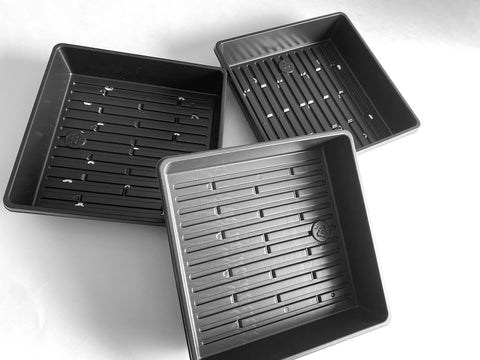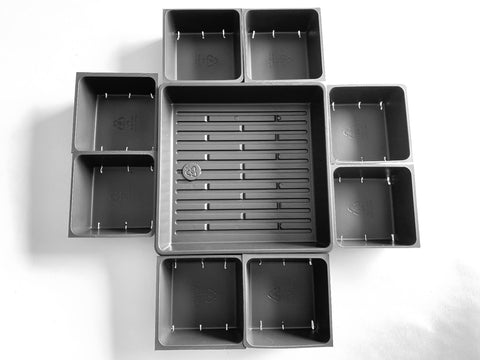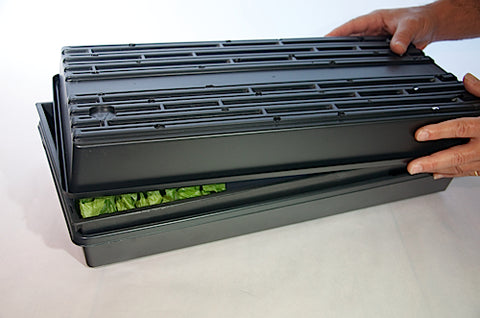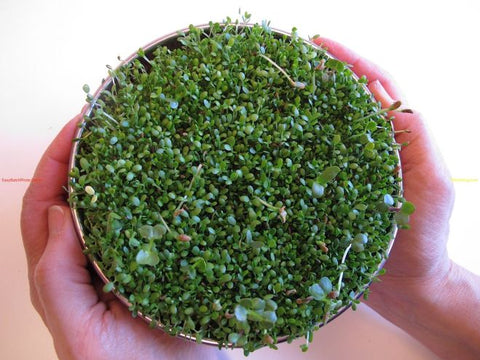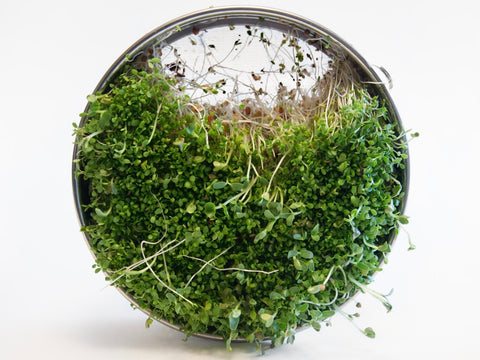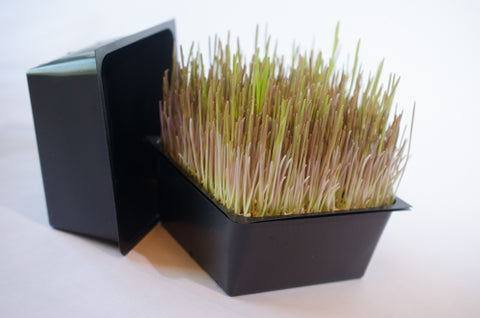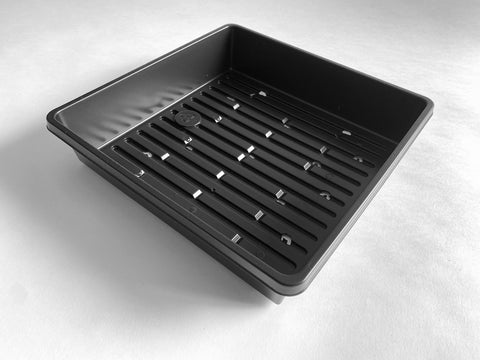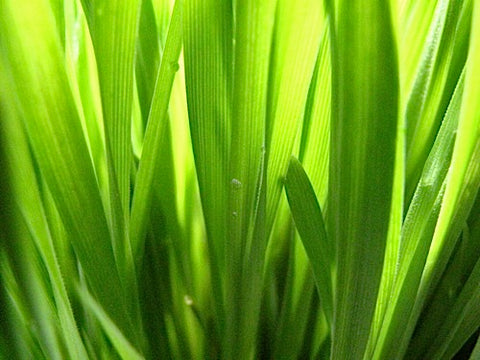
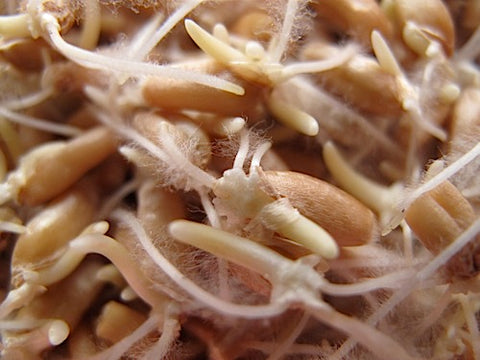
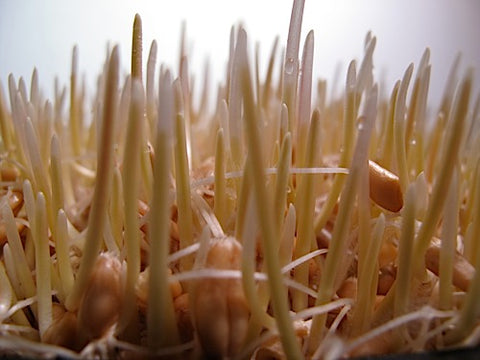
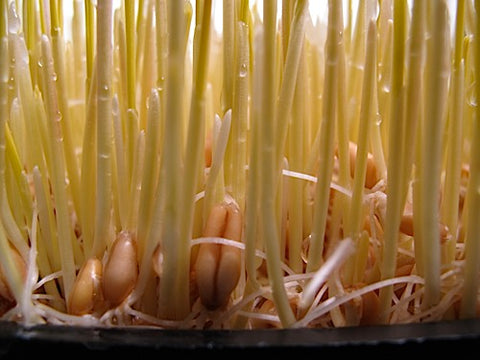
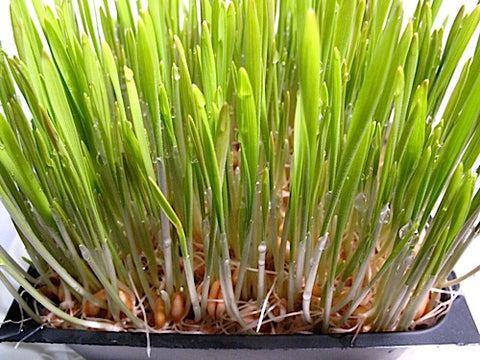
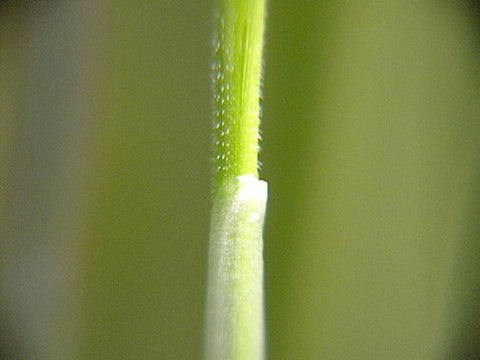
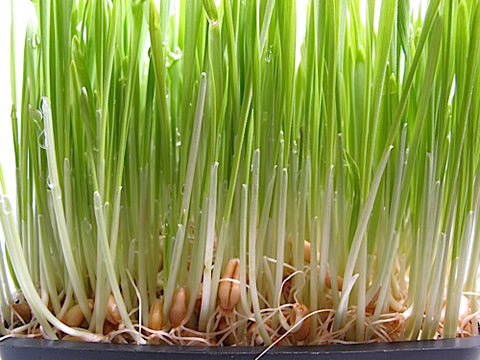
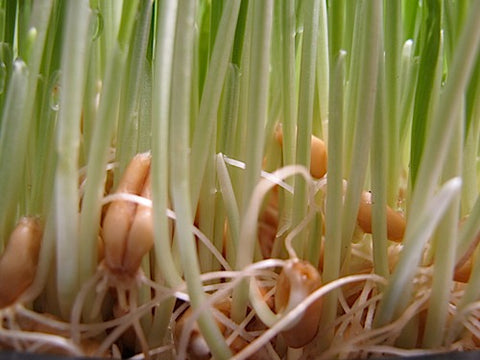
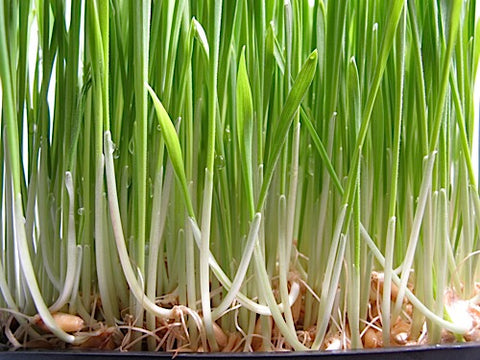
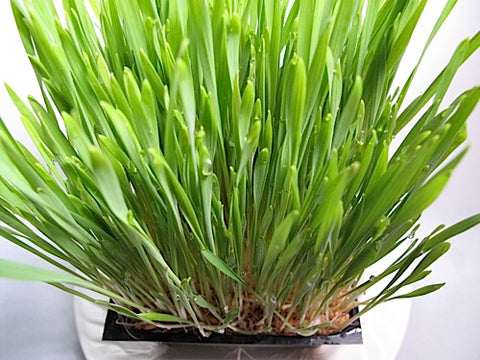
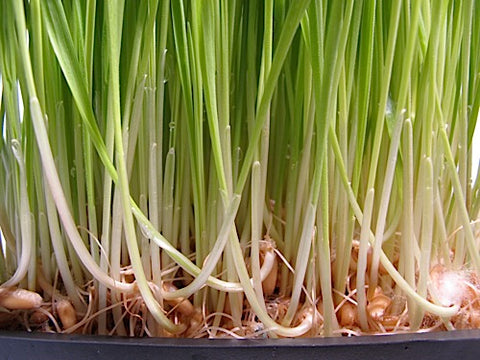
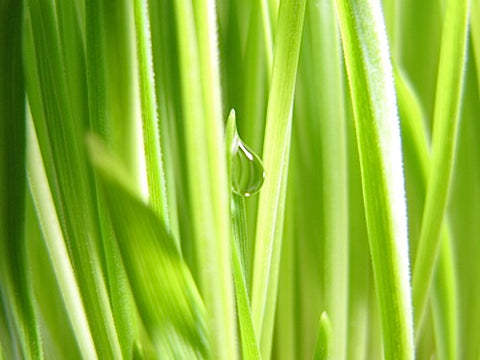
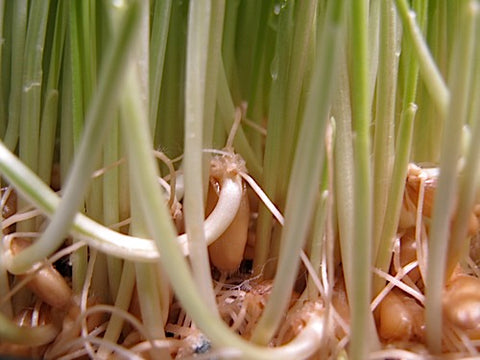
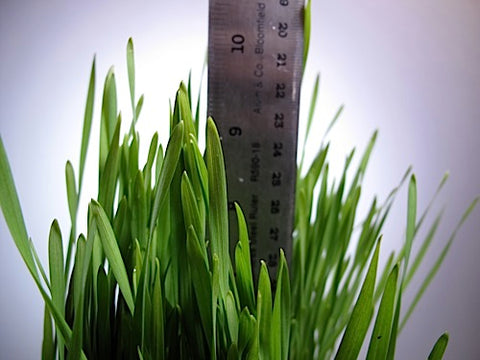
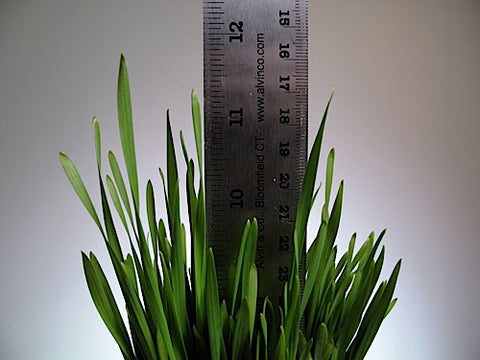
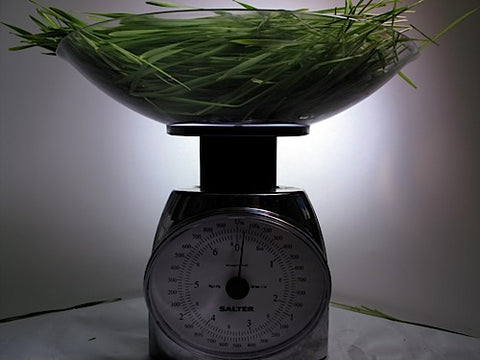
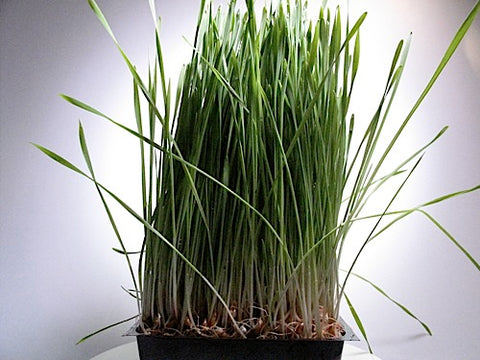
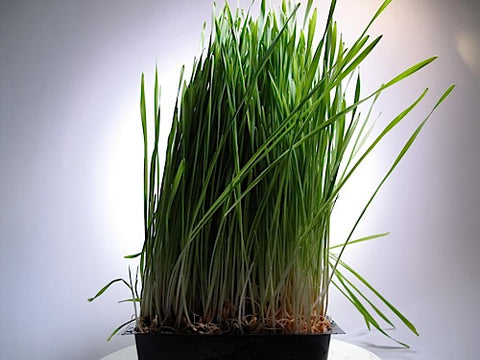
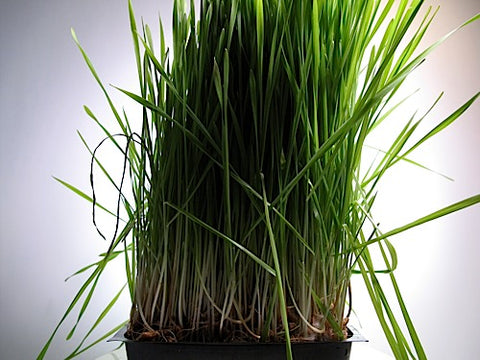
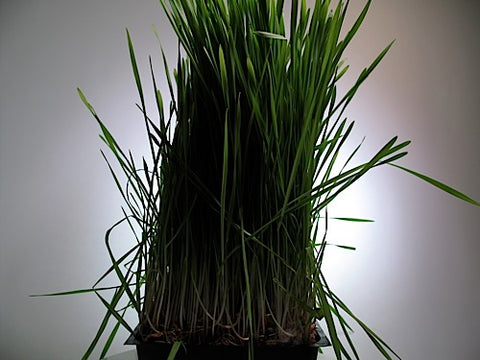
Triticale Grass
An awesome, when available, beverage Grass with nutritional value very similar to that of Wheatgrass.
Note: This is the same seed we sell for Triticale Sprouts.
Vitamins A, B, C, E and K
Calcium, Chlorophyll, Iron, Lecithin, Magnesium, Pantothenic Acid
Phosphorus, Potassium, Trace Elements,
Amino Acids
Protein: up to 30%
The time it takes to grow a finished 6 - 10 days, or other crop (Micro-Greens, Grass, Greens) from a dry Seed. Note: This "finished" Sprout is our preference. you may grow them for as long as you want! In fact, we suggest that you taste them at every rinse to discover when you like them best.
How to Grow Triticale Grass
Soak 1/4 cup of grain in cool water for 6-12 hours.
Drain off soak water. Do not ever soak again.
Rinse and Drain with cool water every 8-12 hours
until your seeds have the tiniest root showing.
Plant on a thoroughly moistened medium.
Cover your crop with another tray or plate, to keep light out and moisture in.
Keep your medium moist by watering lightly as needed. Don't drench!
When your grass is 1-2 inches tall, remove cover and move your crop to a well lit location.
Harvest when your Grass is 4-12 inches tall by cutting just above the medium, with a scissors or sharp knife.
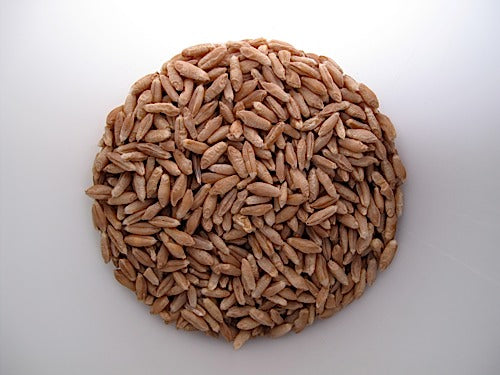
Dry Triticale
awaits Soaking.
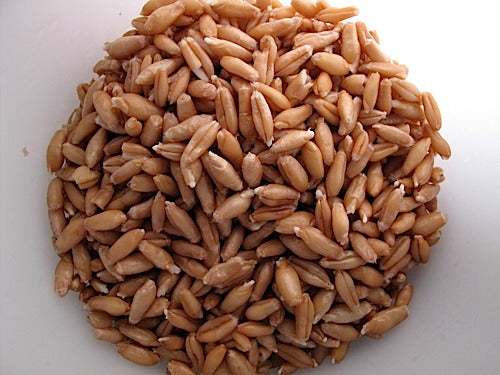
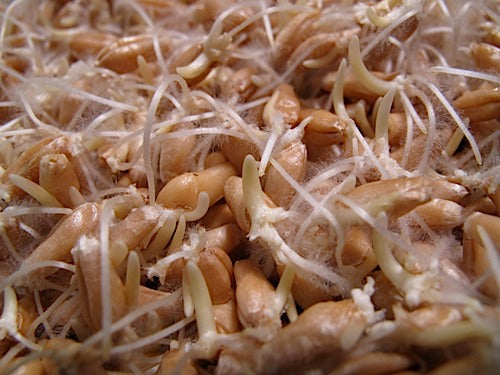
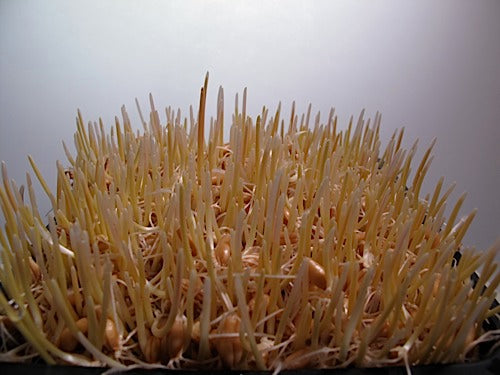
We planted our barely sprouted (pre-sprouted) Triticale atop the thoroughly moistened medium of our choosing, then watered it and covered it. Now - 24 hours later you can see serious growth and Root Hairs too.
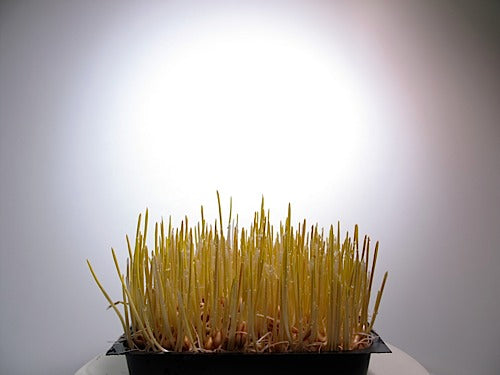
24 hours later...
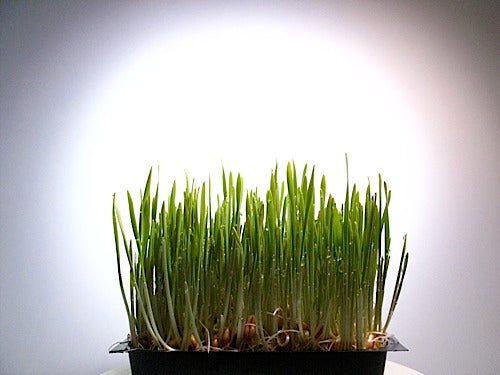
24 hours later...
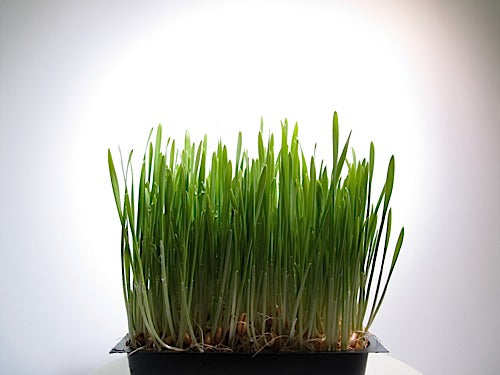
24 hours later...
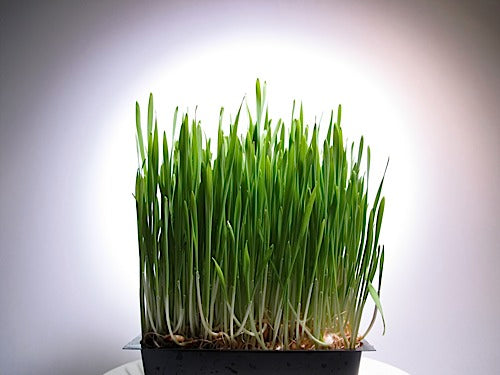
24 hours later...
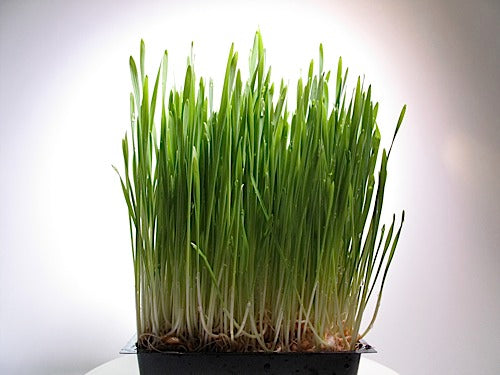
24 hours later...
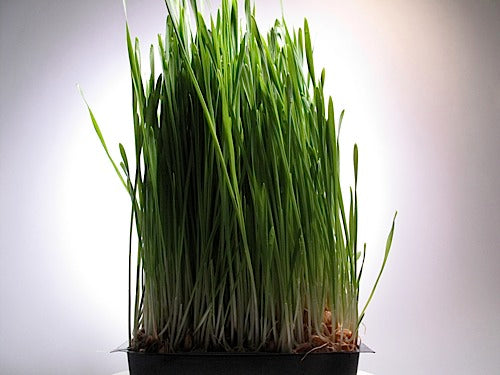
24 hours later...
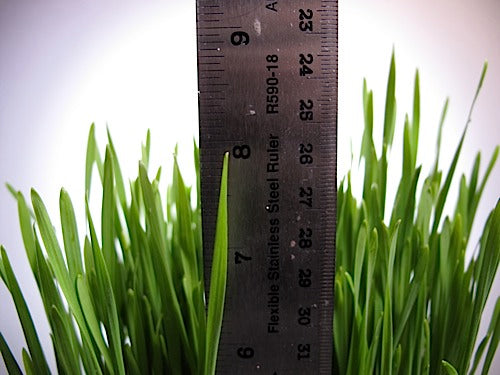
24 hours later...

Dry Triticale
awaits Soaking.



We planted our barely sprouted (pre-sprouted) Triticale atop the thoroughly moistened medium of our choosing, then watered it and covered it. Now - 24 hours later you can see serious growth and Root Hairs too.

24 hours later...

24 hours later...

24 hours later...

24 hours later...

24 hours later...

24 hours later...

24 hours later...
How much you soak depends on the area you are planting - see here. Yields approximately as much Grass (by weight) as Grains planted.
Our Instructions and Notes (below) use Purple Text when referring to growing Grass on a medium other then soil.
Grass will grow much better if you sprout it prior to planting!
Put seed* into a bowl or your Sprouter. Add 2-3 times as much cool (60-70°) water. Mix seeds up to assure even water contact for all. Allow seeds to Soak for 8-12 hours.
Empty the seeds into your sprouter if necessary. Drain off the Soak water. Use it to water plants, or whatever you like. It has nutrients in it.
Rinse thoroughly with cool (60-70°) water and Drain thoroughly.
Set anywhere out of direct sunlight and at room temperature (70° is optimal) between Rinses. This is where your sprouts do their growing. We use a counter top - in the corner of our kitchen, but where the sprouter won't get knocked over by cats, dogs, kids or us. We don't mind the indirect sunlight or the 150 watts of incandescent light, because light just does not matter much. A plant can only perform photosynthesis when it has leaves. Until then light has little if any effect. Don't hide your sprouts.
Rinse and Drain again in 8-12 hours. And, perhaps one more... Rinse and Drain in 8-12 hours. And, conceivably one more... Rinse and Drain in 8-12 hours.
The goal is to have a just the hint of a Root - or a very short Root before planting. Most of the seeds will have that hint, or have sprouted tiny (1/16 - 1/8 inch) roots after just 1 or 2 Rinse and Drain cycles.
Planting
Thoroughly moisten the soil. Allow puddles to dry. Sometimes you may need to use your fingers to make sure the soil is moist all the way down to the bottom of the tray. Water, mix, water, mix, etc. Sometimes you don't have to do that - it depends mostly on how dry the soil is before you begin moistening it.
Baby Blanket/Tencel: Prepare the pad: Cut it to fit your Tray if necessary. Soak it in water or better yet, Kelp Fertilizer enriched water (You don't NEED fertilizer for Grass, but we sometimes use it when we grow without soil.) until thoroughly saturated (fold it up and push it into the liquid - use a pot or bowl or something similar to hold it). Unfold it and re-fold differently or do whatever makes sense - the goal is to get the pad THOROUHGLY soaked. Spread the wet pad across the bottom of your Planting Tray. Proceed...
Vermiculite: Vermiculite absorbs liquid so readily and holds it so supremely that you need little of it. We use 3 Cups for an 10 x 10 inch tray and 6 Cups for an 10 x 20 inch tray. If you're using another tray, make it 1/4 - 1/2 inch deep. Spray water evenly across the surface then spread it out as evenly as you can. We like to use Kelp Fertilizer enriched water (You don't NEED fertilizer for Grass, but we sometimes use it when we grow without soil.) so we just pour it on until thoroughly saturated and then spread it out. If you are using one of our Tray Sets, you can use the Drip Tray to help. The amount of liquid to use is this: a little more than one quart for an 10 x 20 inch tray. You don't want more than a little left in the Drip Tray. Pour off what water remains above the ridges of the Drip Tray. Proceed...
Spread seeds evenly on thoroughly moistened soil or medium. Rinse your seeds one last time and then sprinkle them across the planting medium. Spread them out as evenly as you can. We use a lot of grain and though some literature will tell you that your seeds should not ever lay atop each other, we have found from years of experience and thousands of Trays of Grass grown that that is bunk! You will learn for yourself that Grass produces a plant that takes up less room than the grain did, and so to maximize your yield your seeds must lay atop each other to some degree. The thing to watch is this: If you find mold or fungal problems in your Grass then lessen the amount of grain you plant. The hotter/more humid your climate is the more of an issue the mold/fungus is. As always, you need to adapt to your own climate and seasonal conditions. And learn as you go - this is really easy and fun stuff to learn!
Cover the planted tray with an inverted tray (the Cover Tray) - to keep light out and moisture in. By inverted I mean that the lip of the Cover Tray rests directly on the lip of the Planting Tray - so the bottom of the Cover Tray is facing up.
Note: Your covering tray should have holes or slits in it so that some air circulation exists. Without this very minimal air flow you might have mold or fungal problems.
Place in a low-light, room temperature location. 70° is always optimal but Grass will grow very well in cooler temperatures also.
Watering
Water lightly once or twice a day. The goal is to keep the sprouts moist until their roots bury themselves in the soil/medium - at which point your goal is to keep the soil/medium moist. Spraying the sprouts is best - whether you use a Spray Bottle or sink/faucet sprayer - just try to make sure that every sprout gets rinsed and quenched until they bury their roots. You may also use some Kelp Fertilizer if you like.
Water the medium. Once the roots are buried, all you need to do is keep the medium moist - the seeds and subsequent Grass will get the moisture they need through their roots. Water from the side if possible, to prevent injuring the tender blades.
The Soilless alternative. Baby Blanket and Tencel will dry out more quickly than soil in most circumstances, so you should either water more often or experiment with our somewhat risky trick:
Use the Drip Tray to hold some water. The roots will actually sit in this, so don't go crazy - too much can drown your plants and/or lead to fungal or mold problems. Just leave as much water as the Grass can drink in a day - and then add more the following day. The amount is dependant on the climate (humidity especially) you're growing in, so you'll have to learn this for yourself. We suggest that you start with 1-2 cups in the Drip Tray. Lift the Planting Tray to see how much is left after 4, 8 and 12 hours. If the Drip Tray is dry add more water - if there is still water 24 hours later then cut back the next time you add water. Pretty simple really, and not as risky as we make it sound - it is really a time saver and can produce happier healthy grass. Leaving too much water for too long will lead to funkiness. The roots can go brown, and the smell will be unpleasant. Just keep an eye open and use common sense. Be the plant!
Once again, we do recommend Kelp Fertilizer enriched water for soilless growers. Soil growers may use it too of course, but the soil does have some nutrients already, so it is not nearly as important for you.
Vermiculite holds water better than anything, but the same method works for it: Use the Drip Tray to hold some water. The roots will eventually grow into this, so don't go crazy - too much can drown your plants and/or lead to fungal or mold problems. Just leave as much water as the Grass and Vermiculite can drink in a day and then add more the following day. The amount is dependant on the climate (humidity especially) you're growing in, so you'll have to learn this for yourself. We suggest that you start with 1-2 cups in the Drip Tray. Lift the Planting Tray to see how much is left after 4, 8 and 12 hours. If the Drip Tray is dry add more water - if there is still water 24 hours later then cut back the next time you add water. Pretty simple really, and not as risky as we make it sound - it is really a time saver and produces happier healthy Grass. Use Kelp Fertilizer too. We probably give more water than is necessary, but we end up with great crops and the Grass keeps growing even after we cut it - even if we don't add water daily. Vermiculite is great stuff!
Uncover your Grass on day 3, 4 or 5 - or whenever it's 1-2 inches tall. We usually wait until it pushes the covering tray up (it really will do that - it is remarkable!)
Move to a well lit location If you use direct sunlight (a very good idea for Grass) be prepared to do more watering. Every crop needs more watering when grown in a brighter, hotter location. Keep it moist by watering the soil/medium daily. Watch it grow. It takes about 4 or 5 more days to get to....
Harvest by cutting the Grass just above the soil/medium when the Grass is 6 or more inches tall (actually height is just a matter of yield - you can cut it any time you want to).
We believe that you will get the best flavor and nutrition from freshly cut Grass. We cut JUST prior to juicing and we feel the difference! But, you are better off juicing week old Grass than no Grass at all, so do what you must! Drink More Juice!
If you are going to store your crop: During the final 8-12 hours minimize the surface moisture of your Grass - it will store best in your refrigerator if it's dry to the touch. So if you water try to keep the water off the plants - just water the soil/medium.
Transfer your crop to a plastic bag or the sealed container of your choice. We offer a great Produce Storage Bag which extends the shelf life of all produce stored within it. Whatever you use, put your crop in your refrigerator. Use it/juice it as soon as possible.
Amount of Seed to Use
If using Sproutpeople's Single Harvest Pack - use the whole bag on our 5 inch tray (or similar).
Or Use: 1/4 - 1/3 Cups Dry Grain for a 5 inch square Tray. 1 - 2 Cups dry grain for an 10 inch square Tray. 2 - 4 Cups dry grain for for an 10 inch x 20 inch Tray.
The surest way to know what amount of seed to use: Spread dry seed on the bottom of your Tray so that the seed is spread evenly but densely.
Triticale (Trit-i-Kay-lee) is a fairly new grain - created just over 100 years ago in Scotland and Sweden. A combination of Wheat and Rye (not a genetically modified organism - this was created using the old-timey methods), it is similar in taste and like other grasses; it is very nutritious. A good crop of Triticale is not always easy to find, though we've had great seed for the past few years. We hope this trend continues, but whatever the case; we only offer Triticale for Grass when it will grow Grass well.
You need a special juicer to extract the nectar from this Grass - it is well worth the effort! Look on our Juicer page for more info.
This year's Triticale is awesome! It grows grass better then any Triticale we've seen in years! Very Vigorous!!!
Seed Shelf Life: 2 years. Store in cool, dark, dry spot. Store in freezer to extend shelf life.


